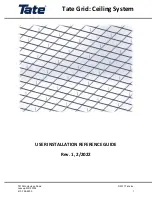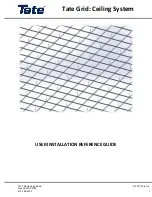
Operator's Manual
WP700Zi-OM-E-RevA
406
1. Press
the
Serial Data Analyzer (SDA)
button on the Quick Access toolbar; or, touch
Analysis
in the menu
bar, then
Serial Data
in the drop-down menu. The display defaults to the "Scope" dialog, which enables
you to set up SDA measurements while you continue to view currently displayed waveforms.
2. Touch
the
Jitter
button. The Jitter Bathtub setup
dialog
is displayed. You can enable
several parameter measurements from this dialog.
3.
For basic measurements, touch the
Basic
button, then touch inside the
@BER(Pow 10)
[The bit error rate
(BER) is the percentage of bits that have errors relative to the total number of bits received in a
transmission. Thus, a BER of 10
-6
means that out of 1,000,000 bits transmitted, one bit was in error.
The BER is an indication of how often a packet of data must be retransmitted because of error. The setting
of the @BER control affects the indicated jitter values by selecting the vertical level at which the width of
the total jitter (integrated TIE histogram) is measured. In general the Tj value will increase with decreasing
bit error rate (more negative power of ten).] field. Enter an exponent value, using the pop-up keypad.
Jitter Filter
The jitter filter is a band-pass filter that is applied to the TIE-vs.-time data measured on the signal under test. The
filtered waveform of the trend of TIE over time is displayed in the waveform grid when Filtered Jitter is selected.
The filter is implemented as an FIR (Finite Impulse Response) digital filter with a maximum tap length of 2000.
Not all high-pass filters are realizable, owing to the tap length restriction or the data record size or both. The
instrument will apply a low-pass filter if the band-pass filter cannot be realized. The filter is applied only to the
filtered jitter trace and does not affect the other jitter measurements: Tj, Rj, Dj etc. The peak-to-peak and rms
value of the filtered jitter trace will be displayed below the trace.
The clock recovery PLL results in a jitter spectrum with a high-pass characteristic determined by the type and loop
bandwidth of the PLL (see the Theory section). The combination of the low-pass jitter filter and the PLL cutoff will
result in a band-pass filter for cases where the jitter filter function cannot realize the high-pass filter selected.
1. Touch
the
Filtered Jitter
button.
2. Touch
inside
the
Lower Limit
field
and enter a value, using the pop-up keypad. To realize
a low pass-filter, select
Set to min.
in the pop-up keypad. In this case the lower frequency cutoff will be set
by the PLL cutoff frequency.
3. Touch
inside
the
Upper Limit
field and enter a value, using the pop-up keypad.
Содержание DDA 7 Zi series
Страница 1: ...Operator s Manual WavePro SDA and DDA 7 Zi Series Oscilloscopes ...
Страница 2: ... L R R H HUD RU D D ...
Страница 41: ...Operator s Manual WP700Zi OM E RevA 40 The detachable WavePro Zi front panel ...
Страница 376: ...WavePro 7Zi 375 WP700Zi OM E RevA Absolute Offset Relative ...
Страница 439: ...Operator s Manual WP700Zi OM E RevA 438 ...
Страница 440: ...WavePro 7Zi 439 WP700Zi OM E RevA ...
Страница 544: ...Thank you for purchasing a WavePro SDA or DDA 7 Zi Oscilloscope ...
















































